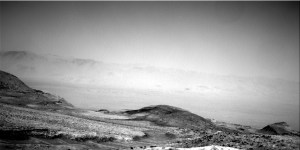Mars: Perseverance (Mars 2020) Perseverance Home Mission Overview Rover Components Mars Rock Samples Where is Perseverance? Ingenuity Mars Helicopter Mission Updates Science Overview Objectives Instruments Highlights Exploration Goals News and Features Multimedia Perseverance Raw Images Images Videos Audio More Resources Mars Missions Mars Sample Return Mars Perseverance Rover Mars Curiosity Rover MAVEN Mars Reconnaissance Orbiter Mars Odyssey More Mars Missions The Solar System The Sun Mercury Venus Earth The Moon Mars Jupiter Saturn Uranus Neptune Pluto & Dwarf Planets Asteroids, Comets & Meteors The Kuiper Belt The Oort Cloud 3 min read
Perseverance Kicks off the Crater Rim Campaign!  Mastcam-Z mosaic made of 59 individual Mastcam-Z images showing the area Perseverance will climb in the coming weeks on its way to Dox Castle, the rover’s first stop on the crater rim. NASA/JPL-Caltech/ASU/MSSS Perseverance is officially headed into a new phase of scientific investigation on the Jezero Crater rim!
Mastcam-Z mosaic made of 59 individual Mastcam-Z images showing the area Perseverance will climb in the coming weeks on its way to Dox Castle, the rover’s first stop on the crater rim. NASA/JPL-Caltech/ASU/MSSS Perseverance is officially headed into a new phase of scientific investigation on the Jezero Crater rim!
For the last 2 months, the Perseverance rover has been exploring the Neretva Vallis region of Jezero Crater, where rocks with interesting popcorn-like textures and “leopard spot” patterns have fascinated us all. Now, the rover has begun its long ascent up the crater rim, and is officially kicking off a new phase of exploration for the mission.
Strategic (longer-term) planning is particularly important for the Mars 2020 mission given the crucial role Perseverance plays in collecting samples for Mars Sample Return, and the Mars 2020 team undertakes this planning in the form of campaigns. Perseverance has now completed four such campaigns— the Crater Floor, Delta Front, Upper Fan and Margin Unit campaigns respectively— making the Crater Rim Campaign next in line. Given its broad scope and the wide diversity of rocks we expect to encounter and sample along the way, it may be the most ambitious campaign the team has attempted so far.
The team also has less information from orbiter data to go on compared to previous campaigns, because this area of the crater rim does not have the high-resolution, hyperspectral imaging of CRISM that helped inform much of our geological unit distinctions inside the crater. This means that Mastcam-Z multispectral and SuperCam long-distance imaging will be particularly useful for understanding broadscale mineralogical distinctions between rocks as we traverse the crater rim. Such imaging has already proved extremely useful in the Neretva Vallis area, where at Alsap Butte we observed rocks that appeared similar to each other in initial imaging, but actually display an Andy-Warhol-esque array of color in multispectral products, indicative of varied mineral signatures.
Our next stop is Dox Castle where Perseverance will investigate the contact between the Margin Unit and the Crater rim, as well as rubbly material that may be our first encounter with deposits generated during the impact that created Jezero crater itself. Later in the campaign, we will investigate other light-toned outcrops that may or may not be similar to those encountered at Bright Angel, as well as rocks thought to be part of the regionally extensive olivine-carbonate-bearing unit, and whose relationship to both Séítah and the Margin Unit remains an interesting story to unravel. Throughout this next phase of exploration, comparing and contrasting the rocks we see on the rim to both each other and those previously explored in the mission will be an important part of our scientific investigations.
The whole Mars 2020 science team is incredibly excited to be embarking on the next phase of Perseverance’s adventure, and we expect these results, and the samples we collect along the way, to inform our understanding of not just Jezero itself, but the planet Mars as a whole. We can’t wait to share what we find!
Written by Eleni Ravanis, PhD Candidate and Graduate Research Assistant at University of Hawaiʻi at Mānoa
Details Last Updated Aug 27, 2024 Related Terms Blogs
Keep Exploring Discover More Topics From NASA Mars
Mars is the fourth planet from the Sun, and the seventh largest. It’s the only planet we know of inhabited…

Explore this collection of Mars images, videos, resources, PDFs, and toolkits. Discover valuable content designed to inform, educate, and inspire,…

Each robotic explorer sent to the Red Planet has its own unique capabilities driven by science. Many attributes of a…

Mars Exploration: Science Goals
The key to understanding the past, present or future potential for life on Mars can be found in NASA’s four…



 4 min read Sols 4284–4286: Environmental Science Extravaganza
4 min read Sols 4284–4286: Environmental Science Extravaganza
 3 min read Sols 4282-4283: Bumping Away from Kings Canyon
3 min read Sols 4282-4283: Bumping Away from Kings Canyon
 2 min read Sols 4280-4281: Last Call at Kings Canyon
2 min read Sols 4280-4281: Last Call at Kings Canyon
